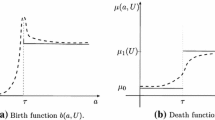Abstract
We consider the question of when delay systems, which are intrinsically infinite dimensional, can be represented by finite dimensional systems. Specifically, we give conditions for when all the information about the solutions of the delay system can be obtained from the solutions of a finite system of ordinary differential equations. For linear autonomous systems and linear systems with time-dependent input we give necessary and sufficient conditions and in the nonlinear case we give sufficient conditions. Most of our results for linear renewal and delay differential equations are known in different guises. The novelty lies in the approach which is tailored for applications to models of physiologically structured populations. Our results on linear systems with input and nonlinear systems are new.
Similar content being viewed by others
References
Asmussen, S.: Applied Probability and Queues. Wiley, New York (1987)
Barbour, A.D., Reinert, G.: Approximating the epidemic curve. Electron. J. Probab. 18, 1–30 (2013)
Breda, D., Diekmann, O., Gyllenberg, M., Scarabel, F., Vermiglio, R.: Pseudospectral discretization of nonlinear delay equations: new prospects for numerical bifurcation analysis. SIAM J. Appl. Dyn. Syst. 15, 1–23 (2016)
Calsina, À., Saldaña, J.: A model of physiologically structured population dynamics with a nonlinear individual growth rate. J. Math. Biol. 33, 335–364 (1995)
de Roos, A.M.: Numerical methods for structured population models: the Escalator Boxcar train. Numer. Methods Partial Differ. Equ. 4, 173–195 (1988)
de Roos, A.M., Persson, L.: Population and Community Ecology of Ontogenetic Development. Princeton University Press, Princeton (2013)
Diekmann, O., Gyllenberg, M.: Equations with infinite delay: blending the abstract and the concrete. J. Differ. Equ. 252, 819–851 (2012)
Diekmann, O., Metz, H.: Exploring linear chain trickery for physiologically structured populations. In: Bij het afscheid van Prof. Dr. H.A. Lauwerier, TW in Beeld, CWI, Amsterdam, pp. 73–84 (1988)
Diekmann, O., Getto, Ph, Gyllenberg, M.: Stability and bifurcation analysis of Volterra functional equations in the light of suns and stars. SIAM J. Math. Anal. 39, 1023–1069 (2007)
Diekmann, O., Gyllenberg, M., Metz, J.A.J.: Finite dimensional state representation of physiologically structured population models (in preparation)
Diekmann, O., Gyllenberg, M., Metz, J.A.J.: Steady-state analysis of structured population models. Theor. Popul. Biol. 63, 309–338 (2003)
Diekmann, O., Heesterbeek, J.A.P., Roberts, M.G.: The construction of next-generation matrices for compartmental epidemic models. J. R. Soc. Interface 7, 873–885 (2010)
Diekmann, O., van Gils, S.A., Verduyn Lunel, S.M., Walther, H.-O.: Delay Equations. Functional-, Complex-, and Nonlinear Analysis. Springer, New York (1995)
Diekmann, O., Gyllenberg, M., Metz, J.A.J., Nakaoka, S., de Roos, A.M.: Daphnia revisited: local stability and bifurcation theory for physiologically structured population models explained by way of an example. J. Math. Biol. 61, 277–318 (2010)
Diekmann, O., Gyllenberg, M., Huang, H., Kirkilionis, M., Metz, J.A.J., Thieme, H.R.: On the formulation and analysis of general deterministic structured population models. II. Nonlinear theory. J. Math. Biol. 43, 157–189 (2001)
Fargue, D.: Réductibilité des systèmes héréditaires à des systèmes dynamiques (régis par des équations différentielles ou aux dérivées partielles). C. R. Acad. Sci. Paris Sér. B 277, 471–473 (1973)
Farina, L., Rinaldi, S.: Positive Linear Systems. Theory and Applications. Wiley, New York (2000)
Gripenberg, G., Londen, S.-O., Staffans, O.: Volterra Integral and Functional Equations. Cambridge University Press, Cambridge (1990)
Gurtin, M.E., MacCamy, R.C.: Non-linear age-dependent population dynamics. Arch. Ration. Mech. Anal. 54, 281–300 (1974)
Gyllenberg, M.: Nonlinear age-dependent population dynamics in continuously propagated bacterial cultures. Math. Biosci. 62, 45–74 (1982)
Gyllenberg, M.: Stability of a nonlinear age-dependent population model containing a control variable. SIAM J. Appl. Math. 43, 1418–1438 (1983)
Gyllenberg, M.: Mathematical aspects of physiologically structured populations: the contributions of JAJ Metz. J. Biol. Dyn. 1, 3–44 (2007)
Kermack, W.O., McKendrick, A.G.: A contribution to the mathematical theory of epidemics. Proc. R. Soc. Lond. Ser. A 115, 700–721 (1927)
Kunkel, P., Mehrmann, V.: Differential-Algebraic Equations: Analysis and Numerical Solution. European Mathematical Society, Zürich (2006)
Leung, K.Y., Diekmann, O.: Dangerous connections: on binding site models of infectious disease dynamics. J. Math. Biol. 74, 619–671 (2017)
MacDonald, M.: Time Lags in Biological Models. Lecture Notes in Biomathematics, vol. 27. Springer, Berlin (1978)
MacDonald, M.: Biological Delay Systems. Cambridge University Press, Cambridge (1989)
Metz, J.A.J., Diekmann, O.: Exact finite dimensional representations of models for physiologically structured populations. I. The abstract foundations of linear chain trickery. In: Goldstein, J.A., Kappel, F., Schappacher, W. (eds.) Differential Equations with Applications in Biology, Physics and Engineering. Lecture Notes in Pure & Applied Mathematics, vol. 133, pp. 269–289. Marcel Dekker, New York (1991)
Miller, J.C.: A note on a paper by Erik Volz: SIR dynamics in random networks. J. Math. Biol. 62, 349–358 (2011)
Miller, J.C., Volz, E.M.: Incorporating disease and population structure into models of SIR disease in contact networks. In: PLoS ONE [E], vol 8, no. 8, Public Library of Science, San Francisco, pp. 1–14 (2013)
Vogel, T.: Théorie des Systèmes Évolutifs. Gauthier-Villars, Paris (1965)
Zadeh, L.A., Desoer, C.A.: Linear System Theory: The State Space Approach. McGraw-Hill, New York (1963)
Zadeh, L.A., Polak, E.: System Theory. McGraw-Hill, New York (1969)
Author information
Authors and Affiliations
Corresponding author
Rights and permissions
About this article
Cite this article
Diekmann, O., Gyllenberg, M. & Metz, J.A.J. Finite Dimensional State Representation of Linear and Nonlinear Delay Systems. J Dyn Diff Equat 30, 1439–1467 (2018). https://doi.org/10.1007/s10884-017-9611-5
Received:
Revised:
Published:
Issue Date:
DOI: https://doi.org/10.1007/s10884-017-9611-5
Keywords
- Linear chain trick
- Delay-differential equation
- Renewal equation
- Markov chain
- Physiologically structured populations
- Epidemic models




